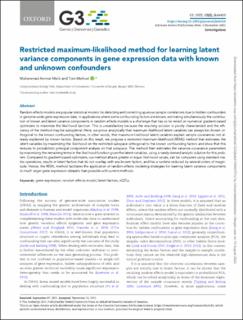| dc.contributor.author | Malik, Muhammad Ammar | |
| dc.contributor.author | Michoel, Tom | |
| dc.date.accessioned | 2022-08-11T06:51:40Z | |
| dc.date.available | 2022-08-11T06:51:40Z | |
| dc.date.created | 2022-05-19T10:34:27Z | |
| dc.date.issued | 2022 | |
| dc.identifier.issn | 2160-1836 | |
| dc.identifier.uri | https://hdl.handle.net/11250/3011196 | |
| dc.description.abstract | Random effects models are popular statistical models for detecting and correcting spurious sample correlations due to hidden confounders in genome-wide gene expression data. In applications where some confounding factors are known, estimating simultaneously the contribution of known and latent variance components in random effects models is a challenge that has so far relied on numerical gradient-based optimizers to maximize the likelihood function. This is unsatisfactory because the resulting solution is poorly characterized and the efficiency of the method may be suboptimal. Here, we prove analytically that maximum-likelihood latent variables can always be chosen orthogonal to the known confounding factors, in other words, that maximum-likelihood latent variables explain sample covariances not already explained by known factors. Based on this result, we propose a restricted maximum-likelihood (REML) method that estimates the latent variables by maximizing the likelihood on the restricted subspace orthogonal to the known confounding factors and show that this reduces to probabilistic principal component analysis on that subspace. The method then estimates the variance–covariance parameters by maximizing the remaining terms in the likelihood function given the latent variables, using a newly derived analytic solution for this problem. Compared to gradient-based optimizers, our method attains greater or equal likelihood values, can be computed using standard matrix operations, results in latent factors that do not overlap with any known factors, and has a runtime reduced by several orders of magnitude. Hence, the REML method facilitates the application of random effects modeling strategies for learning latent variance components to much larger gene expression datasets than possible with current methods. | en_US |
| dc.language.iso | eng | en_US |
| dc.publisher | Oxford University Press | en_US |
| dc.rights | Navngivelse 4.0 Internasjonal | * |
| dc.rights.uri | http://creativecommons.org/licenses/by/4.0/deed.no | * |
| dc.title | Restricted maximum-likelihood method for learning latent variance components in gene expression data with known and unknown confounders | en_US |
| dc.type | Journal article | en_US |
| dc.type | Peer reviewed | en_US |
| dc.description.version | publishedVersion | en_US |
| dc.rights.holder | Copyright 2021 the authors | en_US |
| dc.source.articlenumber | jkab410 | en_US |
| cristin.ispublished | true | |
| cristin.fulltext | original | |
| cristin.qualitycode | 2 | |
| dc.identifier.doi | 10.1093/g3journal/jkab410 | |
| dc.identifier.cristin | 2025498 | |
| dc.source.journal | G3: Genes, Genomes, Genetics | en_US |
| dc.identifier.citation | G3: Genes, Genomes, Genetics. 2022, 12 (2), jkab410. | en_US |
| dc.source.volume | 12 | en_US |
| dc.source.issue | 2 | en_US |

